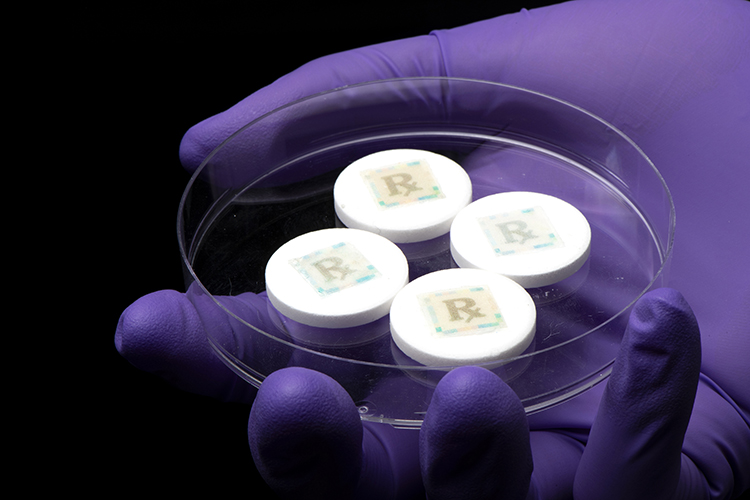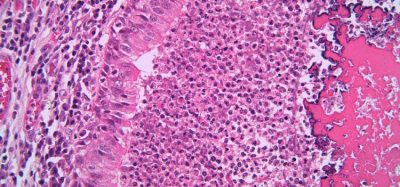Securing every dose with an edible security technology for safe medicines
Posted: 25 August 2022 | Young Kim (Purdue University) | No comments yet
The problem of counterfeit medicines is becoming a tremendous burden to society. An edible security tag affixed to each medicine can provide track and trace measures with dose information and on-dose (in-dose) authentication. Furthermore, it serves as a last line of defence against illicit pharmaceutical products. Young Kim, Associate Head for Research and Professor of Biomedical Engineering at Purdue University, explains more.


FAKE MEDICINES are not a new problem, and pose a tremendous threat to patient safety and public health in society regardless of a country’s economic status. The prevalence of fake drugs is a continually growing problem worldwide. Fake drugs can be categorised as substandard, falsified, counterfeit and diverted drugs, and the World Health Organization (WHO) broadly defines a counterfeit medicine as “one which is deliberately and fraudulently mislabelled with respect to identity and/or source.”1 Simply, pharmaceutical products are the most vulnerable to counterfeiting. Some, 250,000 child deaths per year can be attributed to counterfeit malaria and pneumonia medicines.2 The global counterfeit pharmaceuticals trade is estimated to be worth billions annually,3 bolstered significantly by the increased illicit online pharmacies that emerged during the COVID-19 pandemic.
On- or in-dose authentication means that a security measure or anticounterfeit feature is integrated with the dosage form itself, offering product verification and traceability embedded into each medicine, rather than on the secondary package”
WHO estimates that >50 percent of the drugs for sale on the internet are fake. The US Food and Drug Administration (FDA) further estimates that 97 percent of online pharmacies are operating illegally.4 As a result, various regulatory measures have been implemented to tackle the issue of counterfeit medicines, such as the Drug Supply Chain Security Act (DSCSA) in the US and the Falsified Medicines Directive (FMD) in Europe, which require the implementation of safety features at the secondary packaging, not at the individual unit (primary packaging). Unfortunately, such a chain of custody is not intended to provide patients with the ability to verify their own medicines.
One of the highest protections is to implement on- or in-dose authentication that allows patients to play a key role in combatting illicit pharmaceutical products. On- or in-dose authentication means that a security measure or anticounterfeit feature is integrated with the dosage form itself, offering product verification and traceability embedded into each medicine, rather than on the secondary package. On- or in-dose authentication provides a security measure that directly protects every individual medicine as part of the medicine. However, current anticounterfeiting methods are not appropriate because their constituent materials are not safe for oral consumption.
Depending on security levels, there are several examples of on- or in-dose authentication technologies. The first example is protein-based fluorescent matrix codes, similar to matrix codes.5 Unlike barcodes or quick response (QR) codes, these matrix codes have unique features including being edible, imperceptible and multidimensional. They are also smartphone-readable, generating a digitalised security key augmented by a deep neural network. The second example combines digital and material properties into edible digital watermarking using inkjet printing without introducing material toxicity or cytotoxicity. This allows for a cyber‑physical resilient anti-counterfeiting method for medicines and pharmaceutical products.6 Another example makes use of physically unclonable functions (PUFs) that were originally developed for hardware and information security. All protein‑based PUFs generate cryptographic keys with interactive multiple challenge-response pairs for on‑dose authentication and anti-counterfeiting of medicines.7
![Figure 1: Smartphones can be used to detect a new cyber-physical watermark to determine whether the medication they are taking is real or fake [Credit: Purdue University photo/John Underwood].](https://www.europeanpharmaceuticalreview.com/wp-content/uploads/Kim-Anti-counterfeiting-pharmaceutical-security2.jpg)
![Figure 1: Smartphones can be used to detect a new cyber-physical watermark to determine whether the medication they are taking is real or fake [Credit: Purdue University photo/John Underwood].](https://www.europeanpharmaceuticalreview.com/wp-content/uploads/Kim-Anti-counterfeiting-pharmaceutical-security2.jpg)
Figure 1: Smartphones can be used to detect a new cyber-physical watermark to determine whether the medication they are taking is real or fake [Credit: Purdue University photo/John Underwood].
Such on-dose security technologies have a variety of applications, including serialisation, track and trace, and authentication at the dosage level. First, dosage-level authentication for individual medicines can allow patients to serve as the last line of defence and actively participate in combatting illicit medicines. Second, pharmaceutical companies can implement serialisation of individual medicines, potentially tracking and tracing medicines to ensure brand protection. Third, hospital pharmacies can have more efficient management of drug procurement, distribution and dispensing to hospital inpatients and outpatients. Finally, in clinical studies involving testing medication in home settings, researchers can ensure that participants are self-administering following the study protocol.
The need for advanced authentication and anti-counterfeit technologies for pharmaceutical products is ever-growing as the practices of medication counterfeiting became increasingly advanced during the COVID-19 pandemic. We believe that we need more scientists and researchers to work effectively at the intersection of academia, pharmaceutical companies and government agencies. We hope that this article serves draws attention from the community and makes funding agencies aware of this imperative healthcare sustainability problem.
About the author
Young Kim is the Associate Head for research and Professor of biomedical engineering, university faculty scholar, and Showalter faculty scholar at Purdue University. His spectrum of work appears atypically broad, but his recent research has focused on fusion of material and digital properties to develop mobile health solutions and healthcare security technologies. Initially supported by the cybersecurity programme from the Air Force Office of Scientific Research, he has pioneered several cyber-physical biomedical security technologies for dosage-level anticounterfeit measures and authentication features, including edible physical unclonable functions, edible cyberphysical watermarking and edible matrix codes.
References
- Counterfeit medicines. World Health Organization; 2006. Available from: https://www.gphf.org/images/downloads/library/who_factsheet275.pdf.
- The Guardian. Fake drugs kill more than 250,000 children a year, doctors warn. 2019; Available from: https://www.theguardian.com/science/2019/mar/11/fake-drugs-kill…
- Zaman MH. Bitter Pills: The Global War on Counterfeit Drugs: Oxford University Press; 2018.
- Counterfeit drugs: fighting illegal supply chains: Subcommittee on oversight and investigations of the committee on energy and commerce house of representatives; 2014. Available from: https://www.govinfo.gov/content/pkg/CHRG-113hhrg88828/pdf/CHRG-113hhrg88828.pdf.
- Leem JW, Jeon HJ, Ji Y, et al. Edible Matrix Code with Photogenic Silk Proteins. ACS Central Science. 2022;8(5):513-26.
- Jeon HJ, Leem JW, Ji Y, et al. Cyber-physical watermarking with inkjet edible bioprinting. Adv Funct Mater. 2022;32(18):2112479.
- Leem JW, Kim MS, Choi SH, et al. Edible unclonable functions. Nat Commun. 2020;11(1):328.
Issue
Related topics
Drug Counterfeiting, Drug Safety, Labelling, QA/QC, Regulation & Legislation, Serialisation, Supply Chain, Technology
Related organisations
The World Health Organization (WHO), US Food and Drug Administration (FDA)









